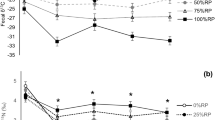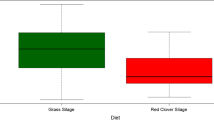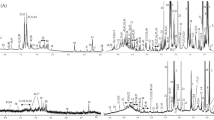Abstract
Plant-wax markers can be used for estimating forage intake, diet composition and supplement intake in grazing livestock, wild ruminants and other mammals. We describe protocols for using the saturated hydrocarbons (alkanes) of plant wax as markers for estimating fecal output, intake and digestibility. Procedures for investigating digestion kinetics are also discussed. Alkanes can also be used to estimate diet composition and the procedures required to do this are also described, including the special case where supplementary feed is treated as a component of the diet composition estimate. The long-chain alcohols (LCOHs) and very long-chain fatty acids (VLCFAs) of plant wax show particular promise for discriminating a greater number of species in the diet. The use of all these plant-wax markers in nutrition studies depends on having quantitative, repeatable and mutually compatible assay procedures for alkanes, LCOHs and VLCFAs; we present protocols for these assays in detail. Analysis of a single sample of feces or plant material for all these plant-wax markers can be completed within 2 days; however, it is possible to process up to 50 samples (analyzed in duplicate) per week.
This is a preview of subscription content, access via your institution
Access options
Subscribe to this journal
Receive 12 print issues and online access
$259.00 per year
only $21.58 per issue
Buy this article
- Purchase on Springer Link
- Instant access to full article PDF
Prices may be subject to local taxes which are calculated during checkout


Similar content being viewed by others
References
Mayes, R.W. & Dove, H. Measurement of dietary nutrient intake in free-ranging mammalian herbivores. Nutr. Res. Rev. 13, 107–138 (2000).
Kotb, A.R. & Luckey, T.D. Markers in Nutrition. Nutr. Abs. Rev. 42, 813–845 (1972).
Dove, H., Mayes, R.W. & Freer, M. Effects of species, plant part, and plant age on the n-alkane concentrations in the cuticular wax of pasture plants. Aust. J. Agric. Res. 47, 1333–1347 (1996).
Dawson, L.A., Mayes, R.W., Elston, D.A. & Smart, T.S. Root hydrocarbons as potential markers for determining species composition. Plant Cell Environ. 23, 743–750 (2000).
Roumet, C. et al. Quantifying species composition in root mixtures using two methods: near-infrared reflectance spectroscopy and plant wax markers. New Phytol. 170, 631–638 (2006).
Tulloch,, A.P. Chemistry of waxes of higher plants. in Chemistry and Biochemistry of Natural Waxes (ed. Kolattukudy, P.E.) 235–287 (Elsevier, Amsterdam, Holland, 1976).
Dove, H. & Mayes, R.W. The use of plant wax alkanes as marker substances in studies of the nutrition of herbivores: a review. Aust. J. Agric. Res. 42, 913–952 (1991).
Dove, H. & Mayes, R.W. Plant wax components: a new approach to estimating intake and diet composition in herbivores. J. Nutr. 126, 13–26 (1996).
Dove, H. & Mayes, R.W. Using n-alkanes and other plant wax components to estimate intake, digestibility and diet composition of grazing/browsing sheep and goats. Small Ruminant Res. 59, 123–139 (2005).
Mayes, R.W., Dove, H., Chen, X.B. & Guada, J.A. Advances in the use of faecal and urinary markers for measuring diet composition, herbage intake and nutrient utilisation in herbivores. in Recent Developments in the Nutrition of Herbivores (eds. Journet, M., Farce, M.-H. & Demarqully, C.) 381–406 (INRA Editions, Paris, 1995).
Mayes,, R.W. & Dove,, H. The use of n-alkanes and other plant-wax compounds as markers for studying the feeding and nutrition of large mammalian herbivores. in Herbivores: The Assessment of Intake, Digestibility and the Roles of Secondary Compounds (eds. Sandoval-Castro, C.A., DeB Hovell, D.B., Torres-Acosta, J.F.J. & Ayala-Burgos, A.) 153–182 (BSAS Publication 34 (Nottingham, U.K.) 2006).
Oliván, M., Dove, H., Mayes, R.W. & Hoebee, S.E. Recent developments in the use of alkanes and other plant wax components to estimate herbage intake and diet composition in herbivores. Rev. Portuguesa Zootec. 6, 1–26 (1999).
Mayes, R.W. New potential markers for determining diet composition. in Proc. 9th Eur. Intake Workshop, 63–66 (IGER, North Wyke, Devon, UK, 1998).
Mayes, R.W., Lamb, C.S. & Colgrove, P.M. The use of dosed and herbage n-alkanes as markers for the determination of herbage intake. J. Agric. Sci. Camb. 107, 161–70 (1986).
Dove, H. Using the normal-alkanes of plant cuticular wax to estimate the species composition of herbage mixtures. Aust. J. Agric. Res. 43, 1711–1724 (1992).
Mayes, R.W. & Lamb, C.S. The possible use of n-alkanes in herbage as indigestible faecal markers. Proc. Nutr. Soc. 43, 39A (1984).
Malossini, F., Bovolenta, S., Piasentier, E., Piras, C. & Martillotti, F. Comparison of n-alkanes and chromium oxide methods for estimating herbage intake by grazing dairy cows. Anim. Feed Sci. Tech. 61, 155–165 (1996).
Dove, H., Freer, M. & Foot, J.Z. The nutrition of grazing ewes during pregnancy and lactation: a comparison of alkane-based and chromium/in vitro-based estimates of herbage intake. Aust. J. Agric. Res. 51, 765–777 (2000).
Mayes, R.W. & Duncan, A.J. New developments in the use of plant-wax markers to determine intake. in Emerging Techniques for Studying the Nutrition of Free Ranging Herbivores (eds. Dove, H. & Coleman, S.W.) CD-ROM (Vth International Symposium on the Nutrition of Herbivores, San Antonio, TX, April 1999).
Dove, H., Freer, M. & Foot, J.Z. Alkane capsules for measuring pasture intake. Proc. Nutr. Soc. Aust. 13, 131 (1988).
Vulich, S.A., O'Riordan, E.G. & Hanrahan, J.P. Use of n-alkanes for the estimation of herbage intake in sheep: accuracy and precision of the estimates. J. Agric. Sci. Camb. 116, 319–323 (1991).
Giráldez, F.J., Lamb, C.S., López, S. & Mayes, R.W. Effects of carrier matrix and dosing frequency on digestive kinetics of even-chain alkanes and implications on herbage intake and rate of passage studies. J. Sci. Food Agric. 84, 1562–1570 (2004).
Letso, M. A Study of the Use of n-Alkanes to Determine Dietary Intake and Digestibility in Grazing Rabbits. MSc Thesis, University of Aberdeen, (1995).
Dove, H. & Oliván, M. Using synthetic or beeswax alkanes for estimating supplement intake in sheep. Anim. Prod. Aust. 22, 189–192 (1998).
Sehested, J. et al. Use of n-alkanes to estimate grass intake and digestibility in sows. in Emerging Techniques for Studying the Nutrition of Free Ranging Herbivores (eds. Dove, H. & Coleman, S.W.) CD-ROM (Vth International Symposium on the Nutrition of Herbivores, San Antonio, TX, April 1999)..
Elwert, C. & Dove, H. Estimation of roughage intake in sheep using a known daily intake of a labelled supplement. Anim. Sci. 81, 47–56 (2005).
Marais, J.P., Figenschou, D.L., Escott Watson, P.L. & Webber, L.N. Administration in suspension form of n-alkane external markers for dry matter intake and diet selection studies. J. Agric. Sci. Camb. 126, 207–210 (1996).
Hendricksen, R.E. et al. Using molasses as an alternative to controlled release devices for administering n-alkane markers to cattle. Anim. Sci. 76, 471–480 (2003).
Dove, H., Mayes, R.W., Lamb, C.S. & Ellis, K.J. Factors influencing the release rate of alkanes from an intraruminal controlled release device, and the resultant accuracy of intake estimation in sheep. Aust. J. Agric. Res. 53, 681–696 (2002).
Molle, G., Decandia, M. & Dove, H. A comparison between different procedures for dosing n-alkanes to sheep. in Proc. 9th Eur. Intake Workshop, 53–57 (IGER, North Wyke, Devon, UK, 1998).
France, J., Dhanoa, M.S., Siddons, R.C., Thornley, J.H.M. & Poppi, D.P. Estimating the production of faeces by ruminants from faecal marker concentrations. J. Theor. Biol. 135, 383–391 (1988).
Galyean, M.L. Technical note—an algebraic method for calculating fecal output from a pulse dose of an external marker. J. Anim. Sci. 71, 3466–3469 (1993).
Duncan, A.J., Mayes, R.W., Lamb, C.S., Young, S.A. & Castillo, I. The use of naturally occurring and artificially applied n-alkanes as markers for estimation of short-term diet composition and intake in sheep. J. Agric. Sci. Camb. 132, 233–246 (1999).
Giráldez, F.J., López, S., Lamb, C.S. & Mayes, R.W. The use of even-chain alkanes sprayed onto herbage as rate of passage markers in goats. Livestock Sci. 100, 195–202 (2006).
Mayes, R.W., Giráldez, F.J. & Lamb, C.S. Estimation of gastrointestinal passage rates of different plant components in ruminants using isotopically-labelled plant wax hydrocarbons or sprayed even-chain alkanes. Proc. Nutr. Soc. 56, 187A (1997).
Mayes, R.W., Lamb, C.S. & Colgrove, P.M. Digestion and metabolism of dosed even-chain and herbage odd-chain n-alkanes in sheep. in Proc. 12th Gen. Meeting Eur. Grasslands Fed., 159–163 (1988).
Hameleers, A. & Mayes, R.W. The use of n-alkanes to estimate herbage intake and diet composition by dairy cows offered a perennial ryegrass/white clover mixture. Grass Forage Sci. 53, 164–169 (1998).
Dove, H. & Moore, A.D. Using a least-squares optimisation procedure to estimate botanical composition based on the alkanes of plant cuticular wax. Aust. J. Agric. Res. 46, 1535–1544 (1995).
Newman, J.A., Thompson, W.A., Penning, P.D. & Mayes, R.W. Least-squares estimation of diet composition from n-alkanes in herbage and faeces using matrix mathematics. Aust. J. Agric. Res. 46, 793–805 (1995).
Mayes, R.W. et al. Novel approaches to the estimation of intake and bioavailability of radiocaesium in ruminants grazing forested areas. Sci. Total Environ. 157, 289–300 (1994).
Salt, C.A., Mayes, R.W., Colgrove, P.M. & Lamb, C.S. The effects of season and diet composition on the radiocaesium intake by sheep grazing a heather moorland. J. Appl. Ecol. 31, 125–136 (1994).
Hameleers, A. & Mayes, R.W. The use of n-alkanes to estimate supplementary grass silage intake in grazing dairy cows. J. Agric. Sci. Camb. 131, 205–209 (1998).
Dillon, P., Crosse, S., O'Brien, B. & Mayes, R.W. The effect of forage type and level of concentrate supplementation on the performance of spring-calving dairy cows in early lactation. Grass Forage Sci. 57, 212–223 (2002).
Bugalho, M.N., Mayes, R.W. & Milne, J.A. The effects of feeding selectivity on the estimation of diet composition using the n-alkane technique. Grass Forage Sci. 57, 224–231 (2002).
Coleman, S.W., Christiansen, S. & Shenk, J. Prediction of botanical composition using NIRS calibrations developed from botanically pure samples. Crop Sci. 30, 202–207 (1990).
Walker, J.W., McCoy, S.D., Launchbaugh, K.L., Fraker, M.J. & Powell, J. Calibrating fecal NIRS equations for predicting botanical composition of diets. J. Range Manage. 55, 374–382 (2002).
André, J. & Lawler, I.R. Near infrared spectroscopy as a rapid and inexpensive means of dietary analysis for a marine herbivore, dugong Dugong dugon. Mar. Ecol. Prog. Ser. 257, 259–266 (2003).
Fulford,, G. The Potential Use of Plant Hydrocarbons Additional to n-Alkanes as Markers for Estimating Diet Composition in Large Herbivores. MSc Thesis, University of Aberdeen, (1994).
Dove, H. & Oliván, M. The possible use of the alkenes (unsaturated hydrocarbons) of plant cuticular wax as diet composition marker in sheep. in Herbivores: The Assessment of Intake, Digestibility and the Roles of Secondary Compounds (eds. Sandoval-Castro, C.A., DeB Hovell, D.B., Torres-Acosta, J.F.J. & Ayala-Burgos, A.) 1–7 (BSAS Publication 34 (Nottingham, U.K.) 2006).
Ali, H.A.M. The Potential Use of Some Plant Wax Compounds as Faecal Markers to Measure the Botanical Composition of Herbivore Diets. PhD Thesis, University of Aberdeen, (2003).
Ali, H.A.M. et al. The potential of long-chain fatty alcohols and long-chain fatty acids as diet composition markers: development of methods for quantitative analysis and faecal recoveries of these compounds in sheep fed mixed diets. J. Agric. Sci. Camb. 142, 71–78 (2004).
Bugalho, M.N., Dove, H., Kelman, W., Wood, J.T. & Mayes, R.W. Plant wax alkanes and alcohols as herbivore diet composition markers. J. Range Manage. 57, 259–268 (2004).
Ali, H.A.M. et al. The potential of long-chain fatty alcohols and long-chain fatty acids as diet composition markers. J. Agric. Sci. Camb. 143, 85–95 (2005).
Grace, N.D. & Body, D.R. The possible use of long-chain (C19–C32) fatty acids in herbage as an indigestible faecal marker. J. Agric. Sci. Camb. 97, 743–745 (1981).
Ali, H.A.M., Mayes, R.W., Hector, B.L. & Ørskov, E.R Assessment of n-alkanes, long-chain fatty alcohols and long-chain fatty acids as diet composition markers: the concentrations of these compounds in rangeland species from Sudan. Anim. Feed Sci. Technol. 121, 257–271 (2005).
Jayakody, J.A.D.S.S. A Study of the Effects of Human Disturbance on Habitat Use, Behaviour and Diet Composition in Red Deer (Cervus elaphus L.). PhD Thesis, University of Aberdeen, (2005).
Brewer, M.J. et al. A hierarchical model for compositional data analysis. J. Agric. Biol. Environ. Stat. 10, 19–34 (2005).
Dove, H., Scharch, C.P., Oliván, M. & Mayes, R.W. Using n-alkanes and known supplement intake to estimate roughage intake in sheep. Anim. Prod. Aust. 24, 57–60 (2002).
Dove, H., Charmley, E. & Kleven, K. Using n-alkanes to estimate intakes of mixed forages by feeding a known amount of an alkane-labelled supplement. Can. J. Anim. Sci. 83, 641–642 (2003).
Elwert, C., Dove, H. & Rodehutscord, M. Effect of roughage species on faecal alkane recovery in sheep, and the effect of drying treatment on alkane concentration. Aust. J. Exp. Agric. 46, 771–776 (2006).
Christie, W.W. Lipid Analysis 3rd edn. (Oily press, Bridgwater, UK, 2002).
Burdge, G.C., Wright, P., Jones, A.E. & Wotton, S.A. A method for separation of phosphatidylcholine, triacylglycerol, non-esterified fatty acids and cholesterol esters from plasma by solid-phase extraction. Br. J. Nutr. 84, 781–787 (2000).
Oliván, M. & Osoro, K. Effect of temperature on alkane extraction from faeces and herbage. J. Agric. Sci. Camb. 132, 305–312 (1999).
Christie, W.W. Silver ion chromatography using solid-phase extraction columns packed with a bonded-sulfonic acid phase. J. Lipid Res. 30, 1471–1473 (1989).
Carlson, D.A., Roan, C.-S., Yost, R.A. & Hector, J. Dimethyl disulfide derivatives of long chain alkenes, alkadienes and alkatrienes for gas chromatography/mass spectrometry. Anal. Chem. 61, 1564–1571 (1989).
Hulbert, I.A.R., Iason, G.R. & Mayes, R.W. The flexibility of an intermediate feeder: dietary selection by mountain hares measured using faecal n-alkanes. Oecologia 129, 197–205 (2001).
Rao, S.J., Iason, G.R., Hulbert, I.A.R., Mayes, R.W. & Racey, P.A. Estimating diet composition for mountain hares in newly established native woodland: development and application of plant-wax faecal markers. Can. J. Zool. 81, 107–1056 (2003).
Mayes, R.W., Iason, G.R., White, N. & Palo, T. Measuring diet composition and food intake by moose in the Swedish boreal forest: integrating GPS and faecal marker technologies. in Tracking Animals with GPS (eds Sibbald, A.M. & Gordon, I.J.) 77–80 (Macaulay Institute, Aberdeen, Scotland, 2001).
Hatt, J.-M., Lechner-Doll, M. & Mayes, B. The use of dosed and herbage n-alkanes as markers for the determination of digestive strategies of captive giraffes (Giraffa camelopardalis). Zool. Biol. 17, 295–309 (1998).
Wilson, H., Sinclair, A.G., Hovell, F.DeB., Mayes, R.W. & Edwards, S.A. Validation of the n-alkane technique for measuring herbage intake in sows. Proc. Braz. Soc. Anim. Sci., 171 (1999).
O'Keefe, N.M. & McMeniman, N.P. The recovery of natural and dosed n-alkanes from the horse. Anim. Prod. Aust. 22, 37 (1998).
Ordakowski, A.L. et al. Alkanes as internal markers to estimate digestibility of hay or hay plus concentrate diets in horses. J. Anim. Sci. 79, 1516–1522 (2001).
Martins, H., Elston, D.A., Mayes, R.W. & Milne, J.A. Assessment of the use of n-alkanes as markers to describe the complex diets of herbivores. J. Agric. Sci. Camb. 138, 425–434 (2002).
Hatt, J.-M., Mayes, R.W., Clauss, M. & Lechner-Doll, M. Use of artificially applied n-alkanes as markers for the estimation of digestibility, food selection and intake in pigeons (Columba livia). Anim. Feed Sci. Technol. 94, 65–76 (2001).
Hatt, J.-M. et al. The use of dosed and herbage n-alkanes as markers for the determination of intake, digestibility, mean retention time and diet selection in Galapagos tortoises (Geochelone nigra). Herpetol. J. 12, 45–54 (2002).
Gudmundsson, O. & Halldorsdottír, K. The use of n-alkanes as markers for determination of intake and digestibility of fish feed. J. Appl. Ichthyol. Z. Angew. Ichthyol. 11, 354–358 (1995).
Stephen, L., Benton, T.G., Bryant, D.M. & Mayes, R.W. Remote assessment of wild bird diet: an investigation into current and novel tools for dietary estimation. in 90th Annual Meeting of the Ecological Society of America (ESA) and IX Montreal INTECOL congress 7–12th August [abstracts CD-ROM] (2005).
Author information
Authors and Affiliations
Corresponding authors
Supplementary information
Supplementary Protocol
Supplementary protocol for the formation of trimethylsilyl (TMS) derivatives of LCOH (PDF 91 kb)
Rights and permissions
About this article
Cite this article
Dove, H., Mayes, R. Protocol for the analysis of n-alkanes and other plant-wax compounds and for their use as markers for quantifying the nutrient supply of large mammalian herbivores. Nat Protoc 1, 1680–1697 (2006). https://doi.org/10.1038/nprot.2006.225
Published:
Issue Date:
DOI: https://doi.org/10.1038/nprot.2006.225
This article is cited by
-
Preference and possible consumption of provided enrichment and bedding materials and disinfectant powder by growing pigs
Porcine Health Management (2022)
-
Seasonal dynamics of diet–gut microbiota interaction in adaptation of yaks to life at high altitude
npj Biofilms and Microbiomes (2021)
-
Using a Bayesian Hierarchical Linear Mixing Model to Estimate Botanical Mixtures
Journal of Agricultural, Biological and Environmental Statistics (2018)
-
Assessing foraging strategies of herbivores in Mediterranean oak woodlands: a review of key issues and selected methodologies
Agroforestry Systems (2013)
Comments
By submitting a comment you agree to abide by our Terms and Community Guidelines. If you find something abusive or that does not comply with our terms or guidelines please flag it as inappropriate.



